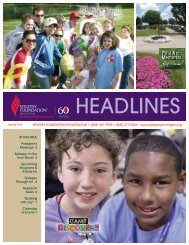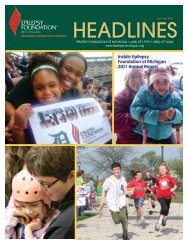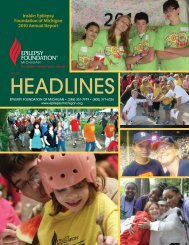Legal Rights of Children with Epilepsy in School & Child Care
Legal Rights of Children with Epilepsy in School & Child Care
Legal Rights of Children with Epilepsy in School & Child Care
You also want an ePaper? Increase the reach of your titles
YUMPU automatically turns print PDFs into web optimized ePapers that Google loves.
What Laws Apply to <strong><strong>Child</strong>ren</strong> <strong>with</strong> <strong>Epilepsy</strong>?<br />
• At least one regular education teacher <strong>of</strong> the student, if he or she is<br />
participat<strong>in</strong>g or may participate <strong>in</strong> regular education<br />
• At least one special education teacher or provider <strong>of</strong> the student<br />
• A representative <strong>of</strong> the school district or the public agency who is qualified<br />
to provide or supervise the provision <strong>of</strong> special education and is<br />
knowledgeable about both the general education curriculum and the<br />
availability <strong>of</strong> the agency’s resources<br />
• An <strong>in</strong>dividual who can <strong>in</strong>terpret the <strong>in</strong>structional implications <strong>of</strong> evaluation<br />
results<br />
• The student, whenever appropriate<br />
• At the discretion <strong>of</strong> the parent or the agency, other people who have<br />
knowledge or expertise regard<strong>in</strong>g the student, <strong>in</strong>clud<strong>in</strong>g related services<br />
personnel, as appropriate. 20 U.S.C. 1414(d)(1)(B); 34 C.F.R. 300.321(a).<br />
2.10Q: What are the related services referred to above?<br />
A: Related services are the developmental, corrective, and supportive services that<br />
help a child <strong>with</strong> a disability benefit from his or her special education. Related<br />
services <strong>in</strong>clude, but are not limited to, transportation, speech and language<br />
therapy, audiology, <strong>in</strong>terpret<strong>in</strong>g services, psychological services, physical<br />
therapy, occupational therapy, recreation (<strong>in</strong>clud<strong>in</strong>g therapeutic recreation),<br />
early identification and assessment <strong>of</strong> disabilities <strong>in</strong> children, counsel<strong>in</strong>g<br />
services (<strong>in</strong>clud<strong>in</strong>g rehabilitation counsel<strong>in</strong>g), orientation and mobility services,<br />
medical services (for diagnostic or evaluation purposes), school health services,<br />
school nurse services, social work services and parent counsel<strong>in</strong>g and tra<strong>in</strong><strong>in</strong>g.<br />
20 U.S.C. 1402 (26); 34 C.F.R. 300.34.<br />
2.11Q: What does “least restrictive environment” mean?<br />
A: The IDEA requires school districts to ma<strong>in</strong>ta<strong>in</strong> a cont<strong>in</strong>uum <strong>of</strong> placements <strong>in</strong><br />
which special education and related services can be provided. The placements<br />
can range from the general education classroom, which is the least restrictive<br />
environment, to a residential special education facility, which is the most<br />
restrictive because it is a separate, full-time, special education facility hous<strong>in</strong>g<br />
only children <strong>with</strong> disabilities. The IDEA requires that a student be placed <strong>in</strong> the<br />
least restrictive environment <strong>in</strong> which his or her IEP can be implemented. 20<br />
U.S.C. 1412(a)(5); 34 C.F.R. 300.115; 34 C.F.R. 300.116. See Chapter 4 for<br />
more general <strong>in</strong>formation about least restrictive environment as well as about<br />
least restrictive environment regard<strong>in</strong>g students <strong>with</strong> epilepsy.<br />
2.12Q: Does the IEP team have additional responsibilities as it develops the IEP?<br />
18<br />
A: Yes. When the purpose <strong>of</strong> the meet<strong>in</strong>g is transition for students out <strong>of</strong> the<br />
education system, the team must <strong>in</strong>vite the student and, if he or she does not<br />
attend, the team must take other steps to ensure consideration <strong>of</strong> his or her








